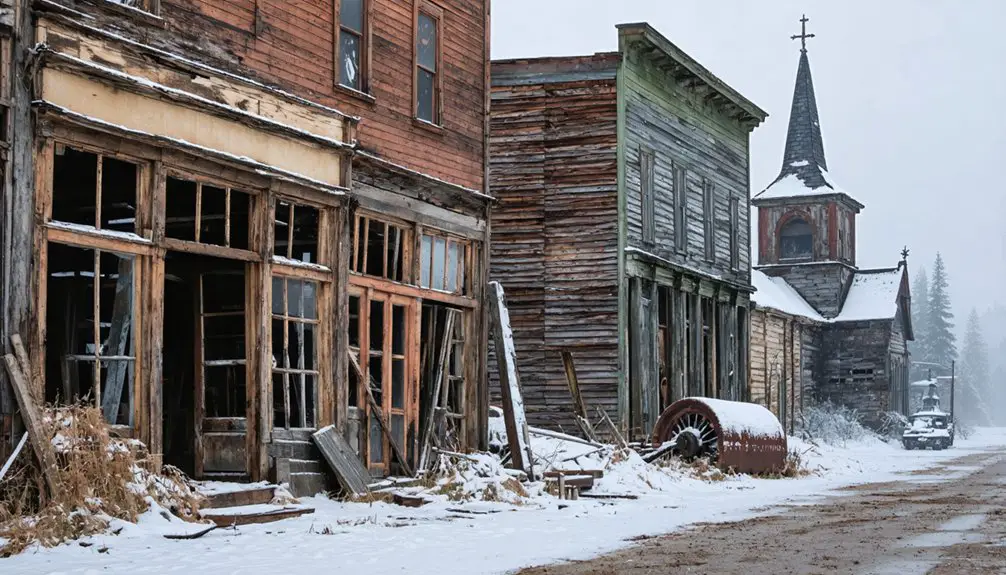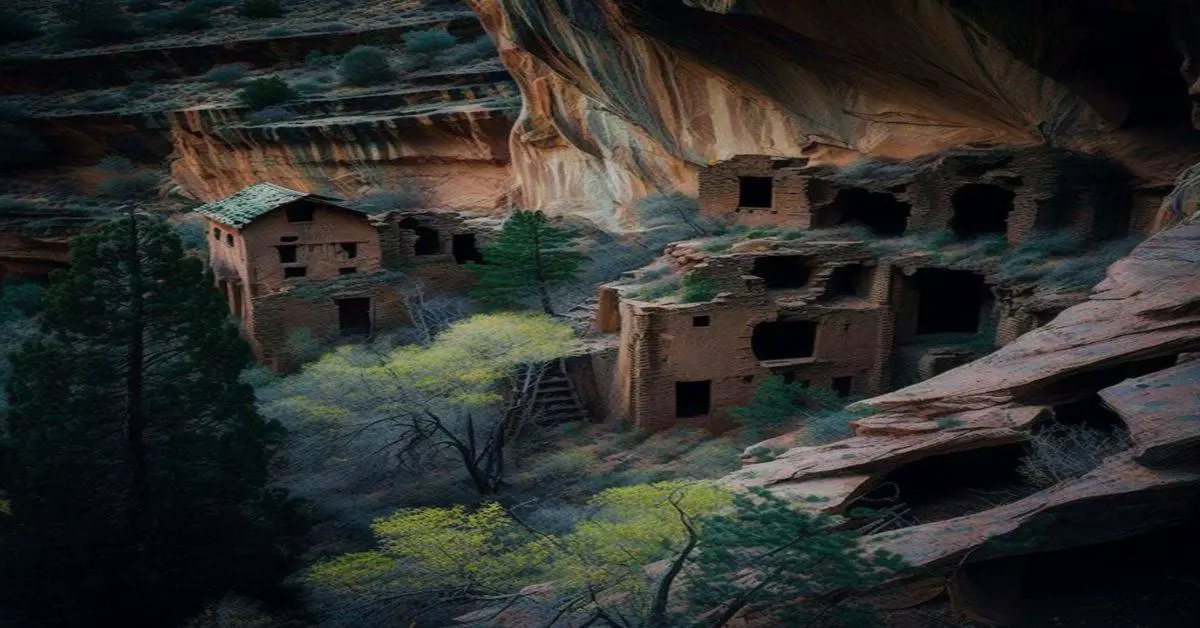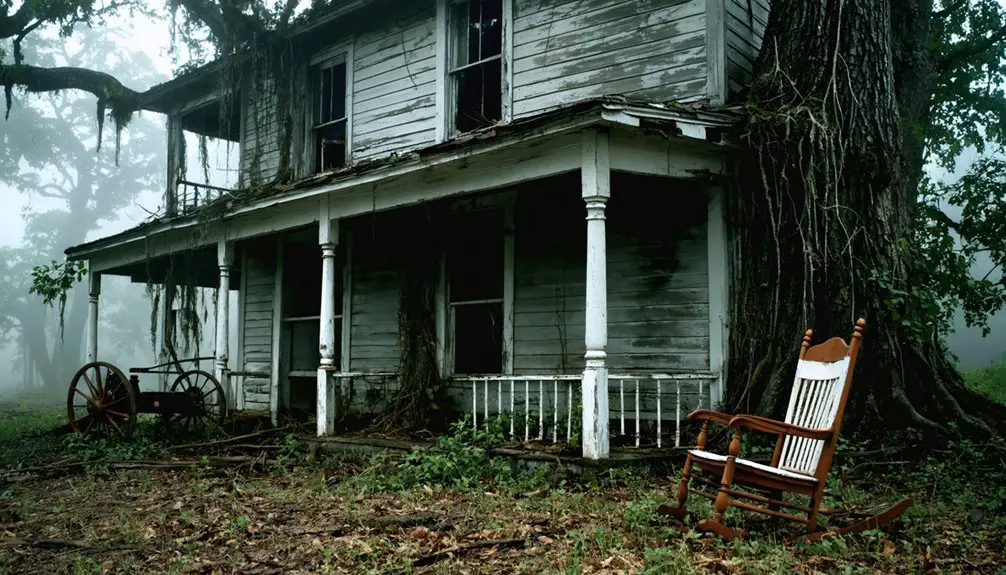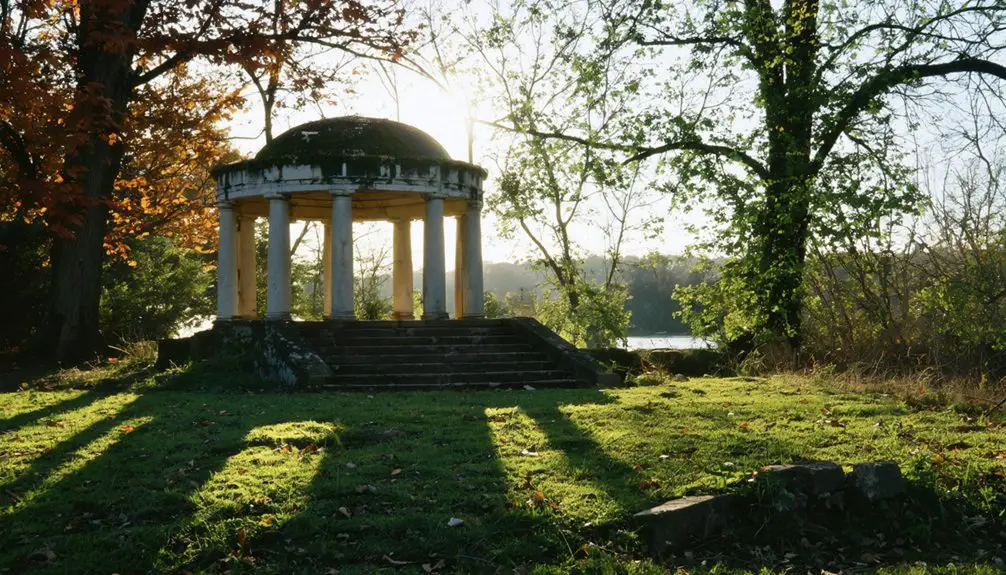You’ll find striking parallels between Alaska and West Virginia’s ghost towns, where mining shaped frontier life in dramatically different landscapes. Both regions showcase abandoned communities from gold rushes and coal booms, with Alaska’s preserved ruins like Kennecott mirroring West Virginia’s historic Thurmond. Natural disasters, from floods to mine explosions, forced many residents to abandon their homes. The stories behind these silent buildings reveal deeper connections between America’s resource frontiers.
Key Takeaways
- Alaska and West Virginia both feature ghost towns shaped by their respective mining industries – gold in Alaska and coal in West Virginia.
- Thurmond, West Virginia maintains five residents among historic buildings, serving as a preserved ghost town with maintained structures and programs.
- Natural disasters, particularly flooding and mine explosions, contributed significantly to town abandonment in both Alaska and West Virginia.
- Preservation strategies differ: Alaska emphasizes minimal intervention, while West Virginia focuses on active stabilization and recreational integration.
- Both states’ ghost towns generate tourism revenue through preserved attractions, maintained trails, and interpretive programs showcasing mining heritage.
The Legacy of Two Mining Frontiers
While both Alaska and West Virginia emerged as significant mining frontiers in American history, their trajectories and impacts unfolded quite differently.
Frontiers may share mining roots, but Alaska and West Virginia carved distinct paths in America’s resource development story.
In West Virginia, you’ll find coal mining’s legacy deeply embedded in places like Thurmond, where railroad-driven commerce shipped an impressive 4 million tons of coal by 1910. The mining methods there evolved from early salt-industry-driven extraction to sophisticated underground operations. The Alaska Coal & Coke Company established a short-lived but notable presence when they built twenty coke ovens near Thurmond.
Alaska’s story centers on gold, with mining methods ranging from placer to modern hard-rock extraction. You’ll see its economic impacts reflected in recent numbers – producing 539,390 troy ounces in 2019 and generating $888 million in 2018. The state’s rich mining heritage dates back to when Russian explorers first discovered gold in the Kenai River in 1848.
While West Virginia’s coal fields remain among America’s most productive regions with 746 million tons of reserves, Alaska continues as the nation’s second-largest gold producer, maintaining its frontier spirit through five major mines.
Environmental Forces and Town Abandonment
When you look at mining ghost towns, you’ll find that natural forces often determined their ultimate fate more decisively than economic factors.
You can trace how devastating floods repeatedly struck many mining communities, washing away essential infrastructure and forcing residents to permanently abandon their homes.
While some towns managed to rebuild after initial disasters, the relentless cycle of environmental destruction eventually convinced even the most determined inhabitants that resettlement was their only option. The use of mountaintop mining methods has permanently transformed many communities like Lindytown into ghost towns through irreversible environmental damage. The presence of acid mine drainage from abandoned coal mines has made waterways toxic and uninhabitable, further pushing residents away from these areas.
Natural Disasters Shape Destiny
Throughout West Virginia’s mining history, devastating coal mine disasters have reshaped the destiny of numerous communities, forcing their eventual abandonment.
You’ll find tragic examples like the 1914 New River Collieries explosion that killed 183 miners, followed by the deadly Benwood and Everettville disasters of the 1920s claiming over 100 lives each.
These natural disasters shattered community resilience, especially in towns nestled within narrow Appalachian hollows where recovery proved nearly impossible.
The environmental impact compounds over time – landslides and ground subsidence triggered by mining have weakened structural stability, while toxic gas concentrations and contamination make areas uninhabitable. The use of mine rescue cars by Pullman Company brought emergency response teams to disaster sites but often too late to prevent town collapse.
Even restored sites like Kaymoor remain vulnerable, their fate sealed by the harsh mountain terrain that once made them ideal for mining. The dramatic decline from over 100,000 jobs to under 20,000 mining positions has left countless communities struggling to survive.
Floods Drive Communities Away
Despite their resilient spirits, West Virginia’s communities have faced devastating displacement due to both natural floods and federally-mandated flood control projects. You’ll find stark examples in places like Gad, where the Summersville Dam project forced entire families to abandon generations-old farmland, and Roseburg, where the 1985 Great Flood destroyed over 100 structures within hours. The community of Gad once featured a thriving farming culture with its own sawmill, church, school, general store, and post office.
Community displacement has manifested in different ways across the state. While some towns like Richwood experienced gradual abandonment through repeated flooding, others like Gad vanished suddenly beneath engineered lakes. The ghostly remnants of this once-thriving community now only emerge during low water days.
The emotional toll on residents has been profound – they’ve lost not just homes but their cultural heritage. What remains are underwater ruins, relocated graveyards, and empty streets that tell stories of flood resilience and sacrifice in the face of environmental forces.
Preservation Through National Parks
You’ll find that the National Park Service employs varied protection strategies at Alaska’s ghost towns, from maintaining structural integrity at Kennecott to allowing natural weathering at more remote sites like Bremner.
Through carefully managed access programs including permitted air taxis and guided tours, you can explore these preserved mining settlements while minimizing impact on their historical authenticity. Since its purchase in 1998 by NPS, Kennecott’s buildings have undergone extensive restoration to protect this remarkable piece of mining history.
The preservation efforts maintain these cultural heritage sites as living museums that tell the story of Alaska’s mining era, frontier life, and the delicate balance between human development and wilderness. Environmental advocates have successfully pushed for mining restrictions through lawsuits in the 1980s that led to closure of small gold mines in national parks.
Park Protection Strategies Differ
When examining ghost town preservation within America’s national parks, Alaska and West Virginia showcase markedly different approaches shaped by their distinct environments and historical contexts.
You’ll find Alaska’s preservation methodologies focus on maintaining remote mining sites with minimal intervention, prioritizing natural landscape protection alongside cultural heritage in vast wilderness areas. In contrast, West Virginia’s strategies, particularly in New River Gorge, emphasize active stabilization and integration with recreational activities.
The ecological considerations in each state dramatically influence protection methods. Alaska’s harsh climate demands robust weatherproofing and controlled access to protect fragile structures, while West Virginia’s parks balance structural reinforcement with forest reclamation.
You’ll notice how West Virginia’s concentrated preservation efforts enable more direct visitor engagement through guided tours and educational programs, whereas Alaska’s sites maintain stricter access limitations to preserve their rugged authenticity.
Managing Historical Site Access
The National Park Service‘s management of historical site access represents a complex balance between preservation and public engagement. Through carefully designed access control measures, you’ll find ghost towns like Thurmond preserved while remaining accessible for exploration.
The NPS implements visitor engagement strategies that protect these invaluable historical sites while ensuring you can experience their authentic character.
- You can explore designated areas through marked trails and guided tours.
- You’ll need ranger assistance to reach remote locations like Sewell.
- You can visit the Thurmond depot visitor center daily between Memorial Day and Labor Day.
These measures protect fragile structures while allowing you to connect with America’s past.
The NPS maintains this delicate balance through seasonal scheduling, interpretive programming, and controlled access points that safeguard these historic treasures for future generations.
Maintaining Cultural Heritage Sites
Preserving cultural heritage sites within national parks demands substantial financial commitments and strategic resource allocation.
You’ll find that maintaining ghost towns requires millions in dedicated funding, with structures like those in Mojave National Preserve needing $2.7 million for repairs across 137 historic buildings.
When you explore these preserved sites, you’re witnessing the results of careful cultural continuity efforts.
Park managers must balance visitor access with protection, investing in everything from road reconstruction to waste management systems.
They’re partnering with local communities and private stakeholders to maintain authenticity, often relying on volunteer support to keep costs manageable.
Through strategic resource allocation, they’re protecting not just buildings, but the complete historical narrative – from mining equipment to water systems – that tells the story of America’s frontier past.
Tales From the Ruins
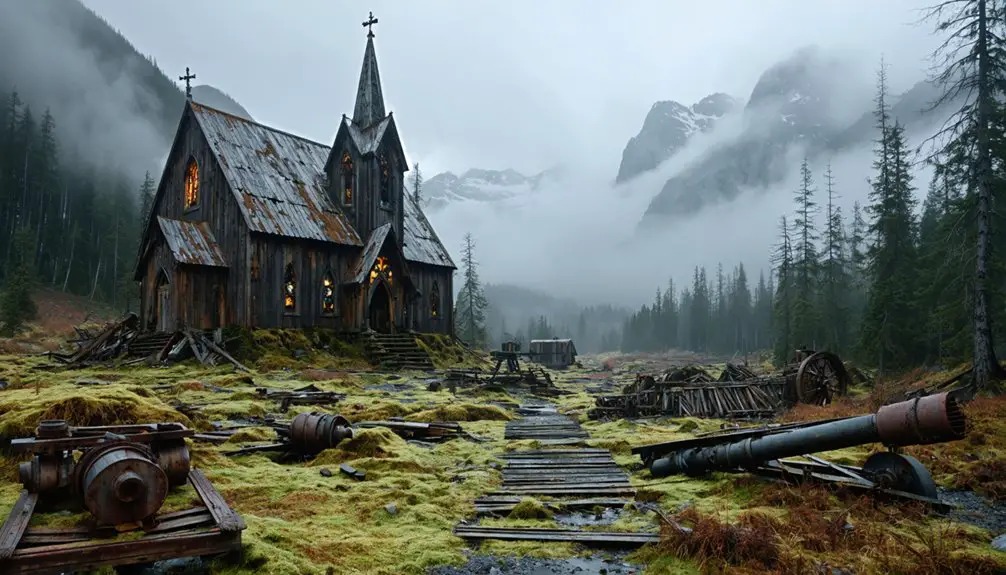
Deep within West Virginia’s abandoned towns, haunting tales and supernatural legends have emerged from crumbling ruins and forgotten cemeteries.
You’ll find ghostly encounters woven into the fabric of local folklore origins, like the famous Zona Histachu story from 1897, where a spirit revealed details of her own murder in Greenbrier County.
- Walk through the flooded town of Gad, where locals claim to hear whispers from relocated graves beneath Summersville Lake’s waters.
- Explore Thurmond’s abandoned buildings, where phantom train whistles still echo through the night.
- Venture into New River Gorge’s overgrown ruins, where apparitions drift through collapsed churches and empty farmhouses.
These tales aren’t just stories – they’re echoes of communities erased by floods, fires, and economic collapse, preserved in the collective memory of those who remain.
Tourism and Heritage Management
Modern heritage management has transformed West Virginia’s ghost towns from neglected ruins into carefully preserved historical attractions. You’ll find thoughtfully managed sites like Thurmond, where the National Park Service maintains historic structures while offering interpretive programs focused on coal mining and railroad heritage.
Through carefully planned heritage tourism initiatives, you can explore these preserved communities via maintained trails, informational kiosks, and guided tours.
Community involvement plays a crucial role, with local stakeholders and former mining families helping guarantee authentic historical representation. While visiting, you’ll benefit from partnerships between parks and local museums that create engaging exhibits and tours.
Though challenges like weathering and limited funding persist, revenue from tourism helps sustain preservation efforts while creating jobs in conservation and visitor services.
Modern Life Among Historic Remnants
Within West Virginia’s ghost towns, a remarkable blend of past and present unfolds as small communities maintain life among historic remnants.
You’ll find modern resilience in places like Thurmond, where five residents make their homes amid historic buildings and the old train depot, now serving as a museum. These communities showcase historical adaptation as they balance preservation with contemporary living.
- Church services continue in Winona, where you’ll discover active congregation members gathering in traditional structures.
- Residents work in tourism and conservation, helping maintain their town’s rich coal mining heritage.
- You’ll witness how locals have adapted historic buildings for modern use while preserving their architectural character.
These living ghost towns prove that you don’t need a large population to keep history alive and meaningful in today’s world.
Frequently Asked Questions
How Long Does It Typically Take for a Town to Become Abandoned?
You’ll find that ghost town history shows typical abandonment causes lead to desertion within 10-80 years, depending on factors like economic diversification, transportation access, and environmental conditions affecting town survival.
What Survival Gear Should Visitors Bring When Exploring Remote Ghost Towns?
You’ll need essential survival gear: navigation tools, shelter equipment, first aid supplies, water purification methods, emergency food, and reliable communication devices to guarantee safe exploration of abandoned settlements.
Are There Laws Protecting Artifacts Found in Ghost Town Sites?
You’ll face strict federal and state laws protecting artifact preservation in ghost towns. Don’t remove items – it’s illegal and diminishes historical significance. Violations can result in hefty fines and imprisonment.
Which Ghost Towns Have the Most Paranormal Activity Reports?
Pristine paranormal hotspots you’ll find in Harpers Ferry, where ghostly Civil War spirits roam, and Parkersburg’s Blennerhassett Hotel, where ghost hunting reveals apparitions. Lewisburg’s Historic District offers frequent supernatural encounters.
How Many People Still Live Full-Time in These Ghost Towns Today?
You’ll find most ghost towns have zero current residents, though rare exceptions exist. Adak maintains fewer than 200 people, but widespread population decline means nearly all these places are completely abandoned.
References
- https://www.youtube.com/watch?v=-EeLwLa2t90
- https://www.youtube.com/watch?v=yBKOIRxeNX0
- https://wvtourism.com/5-wv-ghost-towns/
- https://kids.kiddle.co/List_of_ghost_towns_in_West_Virginia
- https://www.onlyinyourstate.com/experiences/west-virginia/spruce-ghost-town-wv
- https://minesafety.wv.gov/historical-statistical-data/mining-in-west-virginia-a-capsule-history/
- https://en.wikipedia.org/wiki/Gold_mining_in_Alaska
- https://archive.revenuedata.doi.gov/archive/case-studies/boone-logan-and-mingo/
- https://www.nps.gov/articles/thurmond-a-town-born-from-coal-mines-and-railroads-teaching-with-historic-places.htm
- https://theclio.com/entry/60245
